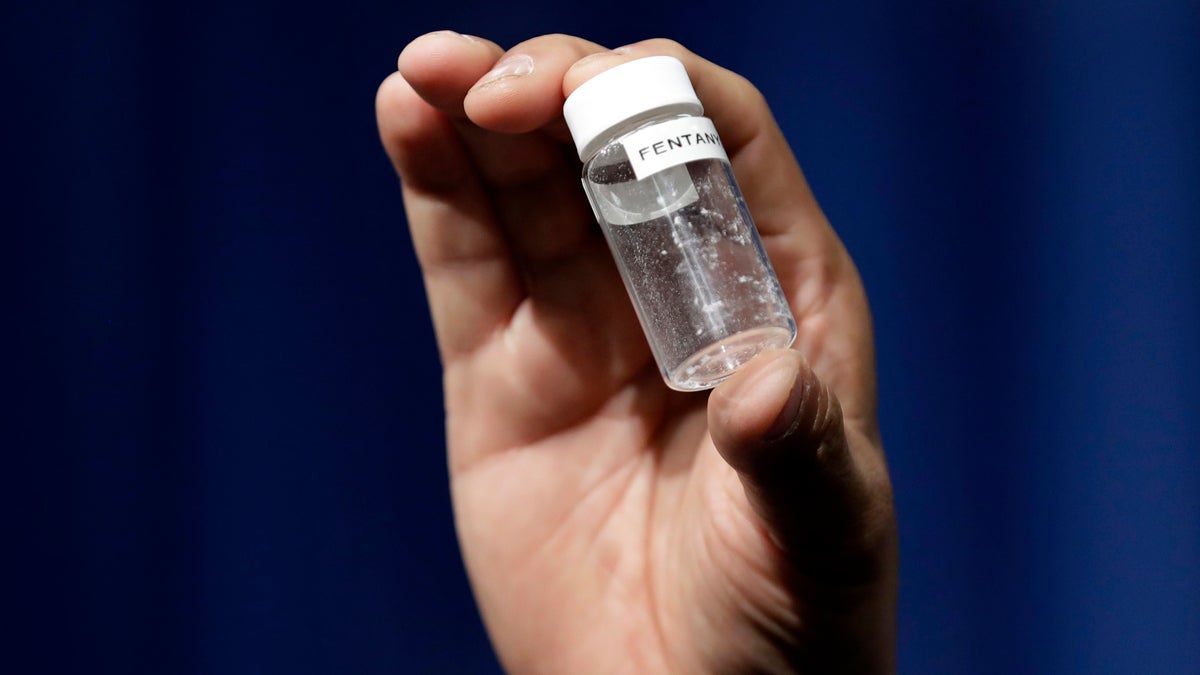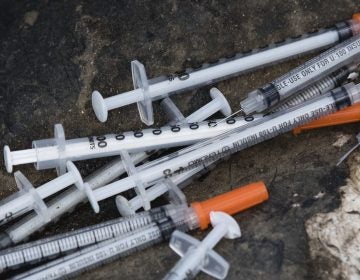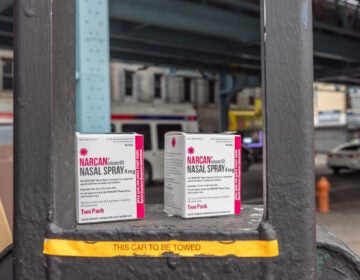Health officials warn of fentanyl contamination after ODs kill 2 crack-cocaine users
Fentanyl, many times stronger than heroin, was responsible for a surge of drug overdose deaths in Philadelphia last year.

A reporter holds up an example of the amount of fentanyl that can be deadly after a news conference about deaths from fentanyl exposure, at DEA Headquarters in Arlington Va., Tuesday, June 6, 2017. (Jacquelyn Martin/AP Photo)
Two people have died in an outbreak of apparent fentanyl overdoses among those using crack cocaine, according to an advisory from the Philadelphia Department of Public Health.
The department said a cluster of 20 crack-cocaine users in West Philadelphia have suffered overdoses since June 16, due to what was likely fentanyl in those drugs. The dangerously potent synthetic opioid, many times stronger than heroin, was responsible for a surge of drug overdose deaths in the city last year. Officials, who said it was the city’s first rash of such overdoses among crack-cocaine users, are now urgently warning these drug users to take precautions against opioid overdose.
The Philadelphia medical examiner’s office is running a toxicology analysis on the two people who died to confirm the cause of death, said Kendra Viner, an epidemiologist at the city’s health department who manages opioid surveillance. The victims had been dead for approximately two to three days when they were found, Viner said, and pipes for smoking crack were found near their bodies.
Overdose survivors taken to Penn Presbyterian Medical Center have already tested positive for fentanyl.
Dr. Brian Work, an attending physician at the hospital and assistant professor at the University of Pennsylvania’s Perelman School of Medicine, treated some of the patients and said they reported having smoked only what they thought was crack cocaine.
“We now have evidence of fentanyl having made it into the crack cocaine supply,” Work said. “I do have to say that I worry very much that fentanyl might make its way into other recreational drugs.”
Viner said she was was alarmed about the drug showing up in people whose drug of choice is cocaine. They may not be as well informed about overdose prevention as those who inject heroin.
“It really is a message to us that we need to expand our education out to really all populations of drug users throughout the city, both geographically [and] demographically,” Viner said.
The health department said most of the victims were African-Americans in their 40s.
Viner said the department’s harm reduction coordinator was doing street outreach in West Philadelphia on Wednesday to encourage crack-cocaine users to take precautions against an overdose, such as not using alone; taking a small “test dose” first; and having naloxone on hand. She said the department was distributing the opioid overdose-reversal medication to those drug users, as well as testing strips they can use to see if their drugs are tainted with fentanyl.
The Kensington harm reduction organization Prevention Point has already begun distributing limited amounts of the strips to people who use its syringe exchange program. Work, also chairman of Prevention Point’s board of directors, said the rash of overdoses would challenge the organization and others working to avert drug deaths to reach groups of people struggling with addiction who aren’t as savvy about the risks of opioids.
“The question, I think, is how to get that message out to the cocaine-using population,” Work said. He said he told the patients he treated at Penn Presbyterian to “tell all of their friends that there is fentanyl to be found in those drugs.”
Health officials noted a significant increase last year in the number of fatal opioid overdoses where cocaine or methamphetamine were present. In 2017, the number of fentanyl-related deaths that involved cocaine rose to 387, up from 162 in 2016. Viner said officials aren’t sure to what extent this was a result of dealers mixing the drugs together or users intentionally taking them together in a combination known as a “speedball.”
But Viner said everyone buying illicit drugs on the street, even recreationally, should be aware of the risk of fentanyl contamination.
“Everyone needs to be alerted that there could be fentanyl in the drugs they’re taking,” she said.
WHYY is your source for fact-based, in-depth journalism and information. As a nonprofit organization, we rely on financial support from readers like you. Please give today.





